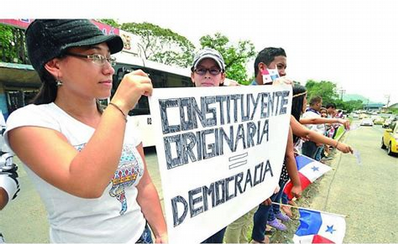Youth reject reforms and demand a Constituent Assembly
The proposal of reforms that Cortizo sent to the Assembly had no technical justification nor support.
- Opinión

The protests of the Panamenian youth and the people against the constitutional reforms proposed by President Laurentino Corteza are the responsibility of those in power. From the beginning, the way the problem was approached was ill calculated by Cortezo’s advisors. The first false move was to accept an exclusionary proposal to reform the Constitution, that was prepared by a group of citizens without any consultation or revision. The second error was that the executive sent it directly to the National Assembly without revising the contents of the reforms proposed. In the process of revision of the proposal by a part of the Assembly, all the Members wanted to get in their say, in total disorder and, still worse, without any partisan or ideological orientation.
The proposal of reforms that Cortizo sent to the Assembly had no technical justification nor support (neither written nor verbal). The manipulation of the package by the members of parliament converted the procedure into a circus. Each member felt free to introduce any article. The circus band stopped playing when the University of Panama raised its voice against the reform that aimed at privatizing higher education through a legislative manouevre. The proposal of a conservative member linked to business interests, touched a very sensitive nerve. The University students, supported by broad sectors of society, brought out their banners and marched from “the house of Méndez Pereira” to the Palace “Justo Arosemena” where the Assembly holds its sessions.
The University Rector, Eduardo Flores, explained to the Members and their Pretorian Guard, shielded behind the railings, what the mission of the University is and the absurdity of the article that they intended to introduce into the Constitution. Neither President Cortizo and the majority of the members of his Cabinet, nor the parliamentary Members, accepted what was proposed by Rector Flores. Nevertheless, the University had another more convincing weapon: the force of its student youth. The demonstrations of student groups from various universities filled the streets that surround the Assembly, in protest. President Cortizo gave the order to quash the article that aimed at suppressing higher education in Panama.
Following the confrontation, the young people joined the protests against the project of Constitutional reforms, objecting to both its contents and its form. To confront the generalized discontent, Cortizo appeeared on television to criticize both the assembly members and the youths, equally. He threatened the use of repression if there was no progress in the calendar of reforms that he had proposed on taking over the Presidency in July 2019.
What is most interesting in this experience is, on the one hand, the maturity and consistency of the youth movements. In addition, they have opened a dialogue with all other sectors of the country. There is just one point on which all the protesters coincide: they do not want the proposed constitutional reforms. The majority want to convene a constituent assembly with full sovereign powers. The clash with the forces of the Government is not only in the political terrain, it is also happening in the streets when the ‘anti-riot squads’ of the National Police repress the youths. There were almost one hundred detained and twice that number of injured.
The government is only waiting to see if Cortizo’s calendar is fulfilled by the end of 2020, with a plebiscite to approve or reject the proposed reforms. The government is counting on the support of the most conservative sectors of the country and everything indicates that they have the (neo-liberal) government and opposition political parties on their side. The response to the reforms by the media, which are owned by the above-mentioned sectors, has been lukewarm. The US Embassy, which has been acephalous for several years, apparently has no major interest in the reform proposals.
The young people support an objective to unite the whole people against the economic class and its government. They want to detain the process of reform. But they add to this objective the convening of an original Constituent Assembly. The struggle between the government and the governed is permanent. What changes is the balance of power. If there is a lot of discontent in the Panamanian family, it could have some probability of success in convening a Constituent Assembly. In that case, it will require work and wide-spread consultations in order to build the structure on which the new Constitution will be founded.
(Translated for ALAI by Jordan Bishop)
November 7 2019
- Marco A Gondásegui, Jr., is Professor of Sociology with the University of Panama and Associate Researcher with the Centro de Estudios Latinoamericnas Justo Arosemena (CELA).
https://marcogandasegui19.blogspot.com/
Del mismo autor
- La pandemia no es el fin del capitalismo 23/04/2020
- Hay que masificar las pruebas contra un virus clasista 19/04/2020
- ¡Qué falta hacen los Comités de Salud de J. Renán Esquivel! 09/04/2020
- La desigualdad social y la desconfianza contribuyen a la epidemia 02/04/2020
- Hacen falta más ‘pruebas’ para ‘suprimir’ el coronavirus 26/03/2020
- La crisis del capitalismo y el coronavirus 19/03/2020
- Urge una movilización general para atacar el corona-virus 12/03/2020
- Se necesita liderazgo y transparencia para enfrentar el corona-virus 05/03/2020
- EEUU veta relaciones entre Panamá y China 27/02/2020
- Roberto Arosemena, sus ideas perduran y sus luchas continúan 20/02/2020
